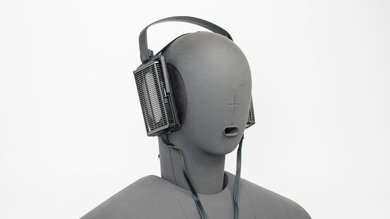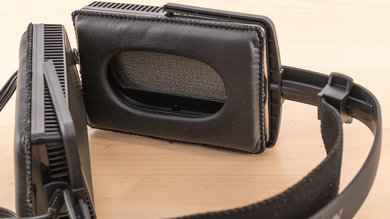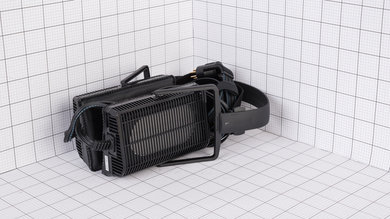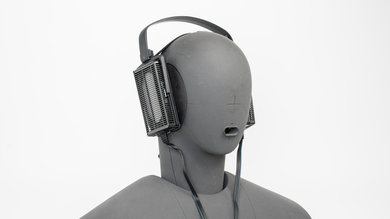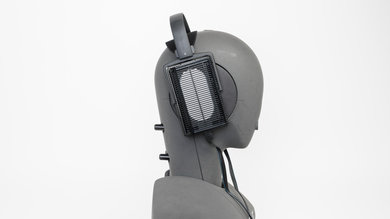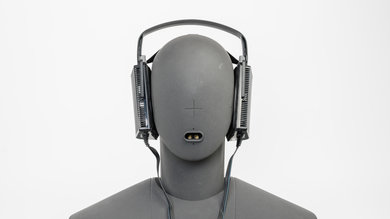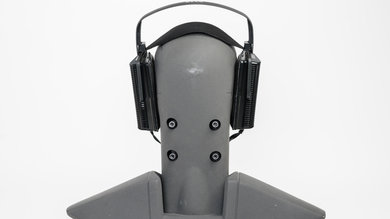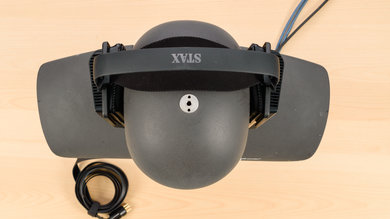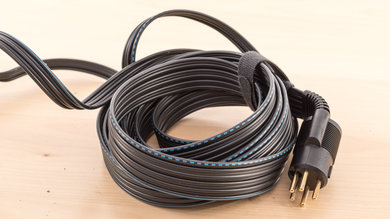The Stax SR-L300 are very good open-back, electrostatic headphones with a unique look. They have wide rectangular ear cups with a grille design that gives them a retro feel. They have great audio reproduction for classical and vocal-centric music and are fairly comfortable. However, their build is very plasticky, and they feel like they could break easily, especially the grilles. They also don’t allow much airflow and get quite warm for open-back headphones. You need a specialized amp or energizer to drive them and enjoy their great sound.
Our Verdict
Bad for mixed usage. The Stax SR-L300 are made for audiophiles and have great audio reproduction. However, they require an energizer to work, and you can't really use them for commuting and physical activity. Also, their open-back design makes them unusable at the office. They have a long cable, but it shouldn’t be long enough for you to watch TV from your couch, and they also don’t have a microphone for online gaming.
- Great audio reproduction.
- Comfortable design.
- Cheap and flimsy build.
- Bulky design.
- Need a specialized amplifier and energizer.
The Stax SR-L300 are very good for neutral listening. Their bass is lacking in lower frequencies but is well-balanced otherwise. On the upside, they have excellent mid and treble ranges, which will reproduce vocals, leads, and cymbals accurately. They might be a bit sibilant for some people due to small bumps in the treble range. These headphones will be better suited for classical and vocal-centric music but won't be a good choice for bass-heavy genres like EDM and hip-hop. Unfortunately, their build quality is sub-par, so it's best to be gentle with these, or you might break them.
The Stax SR-L300 are poor for commuting. You need a specialized amp or energizer to drive these headphones since your smartphone won’t do the trick. They're also leaky, and open-back headphones don’t isolate from ambient noise.
The Stax SR-L300 aren't suitable for sports. They aren’t stable on the head and can fall off. It would be practically impossible to use them during a workout, as you’d need your energizer with you at all times. Even if you were to set your treadmill very close to it, they aren’t breathable headphones, and you’d sweat more than usual.
The Stax SR-L300 are bad for the office. These open-back headphones leak a lot, and those around you can hear what you’re listening to. They also don’t isolate against ambient chatter and other noise in your surroundings.
Sub-par for gaming. The Stax SR-L300 don’t have a microphone for online gaming, but their sound quality is great, and they should be comfortable for long gaming sessions if you take them off now and then to let your ears cool off a bit. If you don’t need a boom microphone, they can be a decent choice for gaming.
Changelog
- Updated Nov 21, 2019: Converted to Test Bench 1.3.1.
- Updated Nov 21, 2019: Converted to Test Bench 1.3.
- Updated Feb 21, 2019: Review published.
- Updated Feb 19, 2019: Early access published.
Check Price
Popular Headphones Comparisons
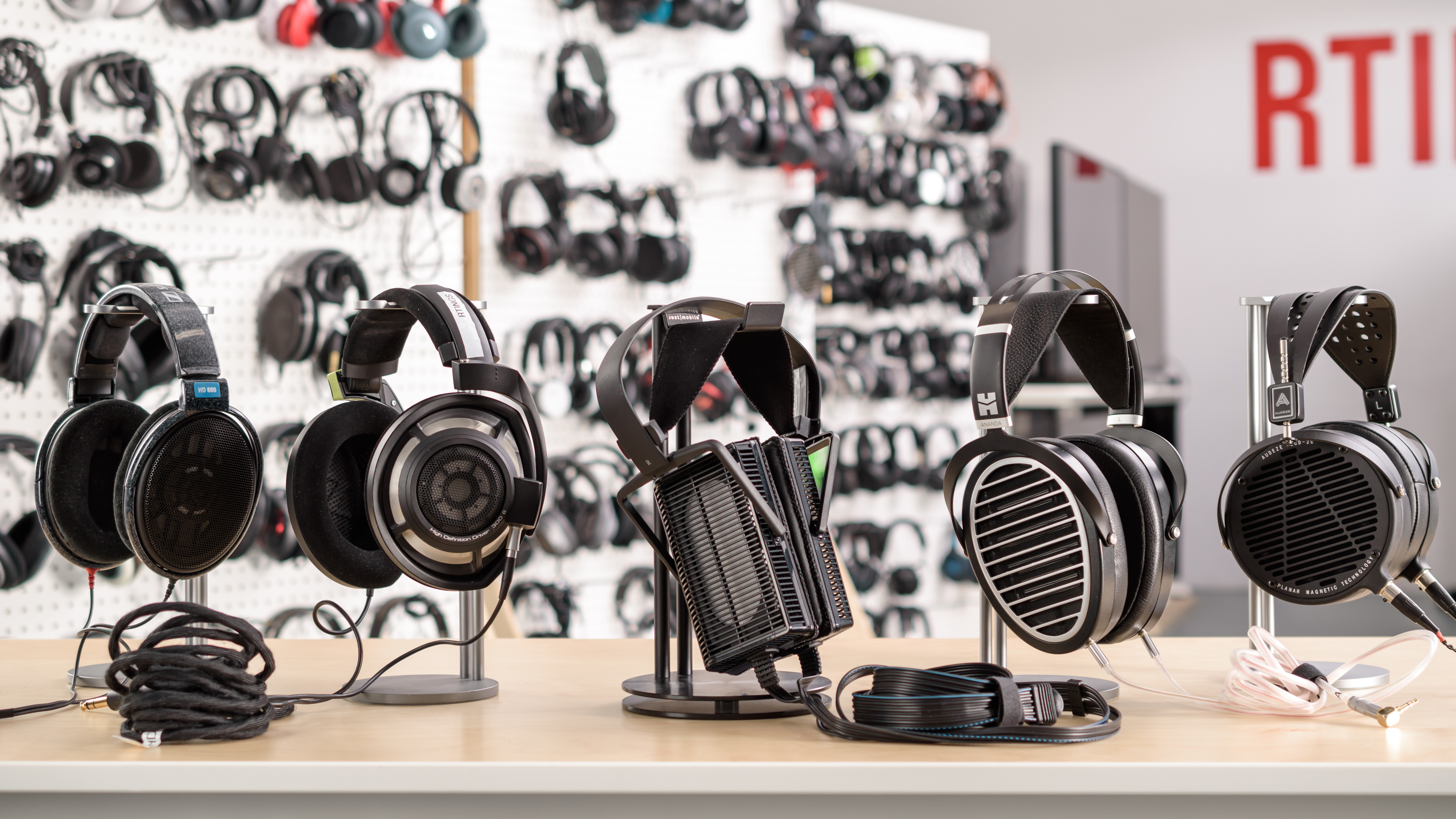
The Stax SR-L300 are very good audiophile headphones that set themselves apart with their unconventional retro look and electrostatic drivers. Unfortunately, they feel very cheaply made and flimsy, which is disappointing for their high-end price tag. If you want better-built high-fidelity headphones to enjoy your music, take a look at our recommendations for the best audiophile headphones.
The Sennheiser HD 800 S are better headphones than the Stax SR-L300 for most people. The Sennheiser are more comfortable for longer listening sessions, and their build is durable, so they don't feel as flimsy as the Stax. Their 1/4" TRS connection is more versatile too. You'll need an amp and energizer to drive the Stax correctly, whereas the Sennheiser only needs an amp. Still, the Stax are significantly cheaper than the Sennheiser.
The Audeze LCD 2 Classic/LC2C are better critical listening open-back headphones than the Stax SR-L300. The Audeze have a very solid build, and their 1/4” connection is more versatile. They deliver more accurate bass and don’t lack low-bass as much as the Stax, but their mid-range is slightly overemphasized, and their sibilants might lack a bit of brightness. The Audeze are also quite tight on the head and are heavy headphones. If you’re looking for critical listening headphones for music that don’t have any low-bass like classical music, the Stax might be a better option; just be careful with them, as they feel very flimsy.
The HiFiMan Ananda are better critical listening headphones than the Stax SR-L300. These planar magnetic headphones are more comfortable and have a great sturdy design. The HiFiMan also pack more bass while still having great mid and treble ranges. They also seem to be more open-sounding. On the other hand, the Stax are more lightweight and have less distortion, for a cleaner audio reproduction.
Test Results
The Stax SR-L300 have a retro look with big rectangular ear cups. The cups are also covered by an open, grilled design. The band holding the cups together is very wide, and you have a small strap that serves as a headband. Unfortunately, they look better than they feel, as the cups are made out of cheap-feeling plastic. Their cable is also very large, heavy, and cumbersome.
While the padding on the cups isn’t very thick, the Stax SR-L300 are comfortable. They don’t apply too much pressure on your head, and the strap keeps everything stable enough for casual listening. However, the cups are fairly shallow, and some people could feel their ear touching the drivers, which is quite uncomfortable. On the upside, they're quite lightweight due to their plastic build, and they feel more comfortable than they look.
The Stax SR-L300 don’t have an in-line remote or controls on the ear cups.
Surprisingly, for open-back headphones, the Stax SR-L300 are not very breathable. They trap quite a lot of heat under the ear cups, and you feel a difference in temperature while wearing them. These are obviously not suited for sports, as you will even feel your ears getting warmer during casual listening sessions.
The Stax SR-L300 aren't very portable. These headphones require a specialized amplifier/energizer to work. Smartphones and laptops can’t drive these headphones, and they're also quite bulky over-ears. These headphones are designed to use at home and should stay in or around the same place.
The Stax SR-L300 feel very cheap. Their build is all made out of plastic. The hinges are thin and feel like a slight impact could break them. The ear cups' grille pattern feels like it could break pretty easily. Also, the size adjustment slider is very flimsy. Overall, the build quality is very disappointing and doesn’t represent their high price tag. However, their all-plastic design choice might be due to their high operating voltage, but we can't confirm this.
The Stax SR-L300 have a decently tight fit, and the large, flat earcups don't lift or wobble much when shaking your head side to side. However, they still slip around a bit when tilting your head forward or backward, and the cables are very cumbersome. You should use these in a stationary position without moving your head too much, or they may fall off. This shouldn't be an issue during listening sessions.
The Stax SR-L300 have decent frequency response consistency. Their bass delivery varies significantly, but the biggest variations were measured in low-bass, which these headphones already lack. Therefore, these variations shouldn’t be that audible since these frequencies are already missing, to begin with. On the upside, they're decently consistent in their treble delivery under 10kHz across multiple reseats.
The Stax SR-L300's bass accuracy is mediocre. The LFE (low-frequency extension) is at 59Hz, which suggests that they won't be able to produce low thump and rumbles. Since lack of low-bass is especially hard to hear on headphones, the overall bass range will be light on thump and rumble, but punchy-enough to be adequate for music that doesn't have a lot of sub-bass (like classical music, music recorded before the 1980s, and podcasts/audiobooks). On the upside, mid and high-bass, responsible for the punch of bass and kick and warmth, respectively, are well-balanced and follow our neutral target curve well.
The Stax SR-L300 have an excellent mid-range performance. The whole range is flat and is within about 1dB of our target curve, which is great. This will result in accurate reproduction of vocals and lead instruments.
The Stax SR-L300's treble accuracy is also excellent. The range is flat and quiet even before 5kHz. However, there’s a small bump at 6.5KHz and an even bigger one at 9kHz, which could make sibilances (S and T sounds) around these frequencies a bit sharp and piercing for some people. Not everyone will hear this as sibilant as others.
The imaging performance is great. The weighted group delay is at 0.41, which is within good limits. The GD graph also shows that almost the entire group delay response is below the audibility threshold. This ensures a tight bass and a transparent treble reproduction. Additionally, the L/R drivers of our test unit were very well-matched, which is important for the accurate placement and localization of objects (instruments, voice, footsteps), in the stereo image. However, these results are only valid for our unit, and yours may perform differently.
The soundstage performance is good. The PRTF graph shows a good amount of accuracy and pinna interaction/activation. However, there is no notch present around 10kHz. This suggests a soundstage that is relatively natural and large but perceived to be located inside the listener's head. Also, because of their very open enclosure, their soundstage will be perceived to be more open than that of closed-back headphones.
By design, the Stax SR-L300 don’t achieve any isolation at all. All the low rumbling sounds in the bass range, speech in the mid-range, or sharp sounds like S and Ts in the treble range will seep into your audio.
The Stax SR-L300 leak a lot, but this is to be expected from open-back headphones. This means the significant portion of their leakage is spread between 450Hz and 20KHz, which is a very broad range. The overall level of their leakage is quite loud too. With the music at 100dB SPL, their leakage at 1 foot away averages at 67dB SPL and peaks at 88dB SPL.
These critical listening headphones don't have a microphone.
They don't have a microphone.
They don't have a microphone.
The Stax SR-L300 don’t have a battery.
There's no dedicated app to enhance your listening experience.
These headphones are not Bluetooth-compatible. Thanks to their wired connection, they don’t have any latency issues and would be suitable to watch video content or gaming.
These headphones need a specialized amplifier/energizer to be used and get audio. We measured them through a Schiit Ragnarok amp and an iFi iESL Pro energizer. Technically, you should be able to route these to your consoles and get audio, but this wouldn’t be common usage.

